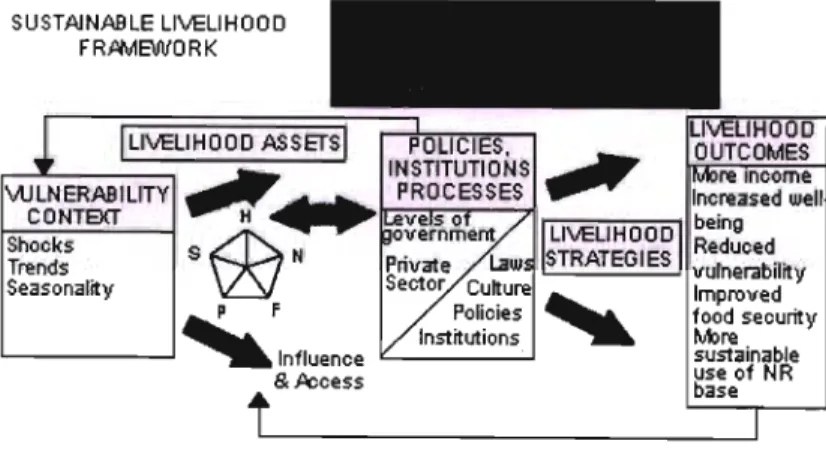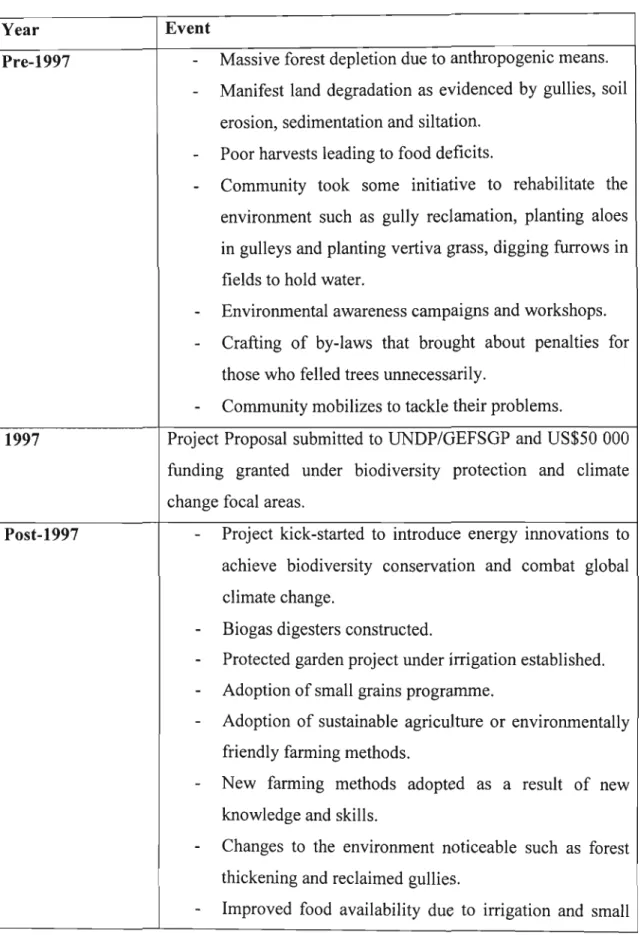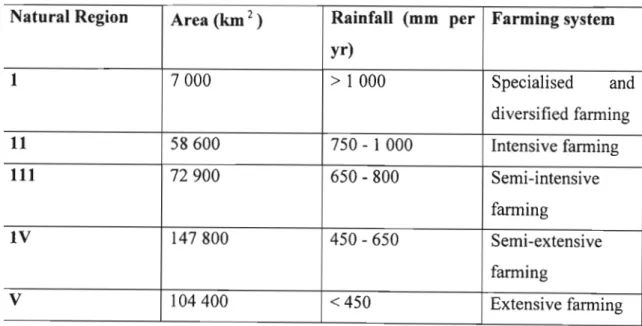This is because the research used a case study method as a way to gain an in-depth understanding of the community. In short, community participation in their own development has been a key factor in the success of their projects.
CHAPTER ONE INTRODUCTION
- Introduction
- Statement of the Problem
- Justification
- Aim of the study
- Outline of the study
To ascertain the extent of forest depletion and food availability before adopting the Sanale project. It also studies the project's impact on their natural environment and livelihood needs.
CHAPTER TWO
LITERATURE REVIEW
Sustainable development
Concepts of sustainability
The pursuit of sustainable development requires a political system that ensures effective participation in decision-making. 34; One of the fundamental prerequisites for achieving sustainable development is broad public participation in decision-making.
Community participation
- Community: defining the concept
- Defining Participation
- Defining community participation
- Participation as key to empowerment
People's involvement or participation in decision-making thus results in democratization of the development process. It requires action from everyone, above all from the population itself.
Levels of community participation
Passive participation People participate by hearing what is going to happen or has already happened. It is a one-sided announcement by an administration or project management without listening to people's reactions. In People participate by answering questions asked by extractive researchers using questionnaire surveys or similar approaches.
Institutions and Participation
With the above in mind, this dissertation will carefully analyze the role played by specific government departments or institutions in facilitating community participation in the community programs of the Insiza community. Some of the obstacles such as excessive pressures for immediate results and techno-financial biases include internal and external characteristics, (Botes and van Rensburg 2000:42).
Why do people seek to manage the environment?
The framework was developed to help understand and analyze the livelihoods of the poor. Aspects of the sustainable livelihood framework will be used in this study to analyze the actions of Sanale community in managing their environment and improving household food security, which is explained below.

Food Security
- Approaches to the concept of household food security
- Indicators of food security
- Food insecurity and environmental degradation nexus
- Conclusion
Improving food security therefore includes all methods that strive to increase sustainable agricultural production of food and promote it. This is because the agricultural sector takes care of supply and demand for food.
Chapter Three Research Methodology
Data Collection Techniques
According to USAID Center for Development Information and Evaluation (1996) key informant interviews are qualitative and in-depth interviews of people selected for their first-hand knowledge about a topic of interest. Often, the questions can be very similar, but the interviews differ based on how they are conducted. Although structured and semi-structured interviews are more neutral than unstructured interviews, in general, interview neutrality is limited.
This is because the method by which secondary data was collected is often unknown to the user of the data (apart from key sources such as the census). This means that the researcher is forced to rely on the skills and correctness of the collectors - usually, but not always, a safe proposition.
Data Analysis
This could have compromised the data as no one would have wanted to say anything negative about certain local leaders. The timing of the survey also coincided with the community preparing for their field day. The chapter has presented an overview of the methods and approaches used in the study.
The chapter also explored factors that influenced the selection of the study area, methodological considerations that included the sampling strategy and limitations of the study.
CHAPTER FOUR
Country of Study
- Zimbabwe Population Statistics
According to PlanAfric (2000), the rural economy of Zimbabwe is strongly influenced by ecology, land tenure and use, population density and land distribution. The 1998 State of Zimbabwe's Environment Report describes the general perception that Zimbabwe's environment is deteriorating with increasing soil erosion/degradation, deforestation, desertification and ineffective environmental laws. Soil erosion remains one of the biggest concerns in Zimbabwe's environmental landscape.
Vivian notes that a national survey of erosion showed that over 10 percent of the land in the country was moderately to extensively eroded.

The Research Area
- Matabeleland South Province
- Insiza District
- Baseline Settings of Sanale Village
- Marital Status
- Number of people in Household
Sanale is an area found in Filabusi Ward 9 under Mpumelelo Village in Insiza District. There were no respondents in the 8 to 25 years category. The age distribution in different categories was deliberate. This may also be due to the fact that the involvement of young people is limited.
In Matabeleland, one of the economic activities, although detrimental to the environment, is gold panning.

Socio-economic characteristics of sample population
- GEFSGP Focal Areas
- Sustainable Agriculture Programme
- Environment Responsive Fund (ERF)
Most of the household respondents also shared the view that raising small grains, groundnuts, round nuts, cowpeas and pumpkins provided cash if surplus was sold. Community workers with prior knowledge of this technology were to assist the community in the construction and use of the ovens. The garden's main purpose is to provide food for the local community with surplus produce sold locally.
It supports organized groups within the most impoverished and marginalized sectors of the population in a number of countries in the South.
Conclusion
CHAPTER FIVE
Research findings on Conservation and environmental issues
- Conservation and Environmental Issues
- State of the forest before project inception
- Initiatives before project inception to combat forest depletion
- Initiatives after project inception
- Importance of the environment to the community
- Livelihood and Food Security Issues
- How households obtain enough food for the month
- Food availability before Project
- Reaction to project
- How is community supportive of project activities?
- Has household benefited from project?
- Are women benefiting from development programmes?
- Conclusion
Most household respondents were of the opinion that the community had taken initiative to rehabilitate their environment. Half of the household respondents noted that they did not take the initiative to increase food themselves. Almost all household respondents were of the opinion that food security had improved as a result of the project.
It will trace the activities of the community prior to the start of the project in 1997.

CHAPTER SIX
Research findings on Participation
What is community?
- What is community participation?
- Reasons for participation in development projects
- Involvement, why, why not? In what way?
It was also suggested that the local project coordinator, Mrs Mafu (not related to the Chief), was instrumental in starting the projects. The focus group was of the opinion that provision is made for the elderly in the form of benefits that accrue to the household. Most of the respondents in the household noted that they are involved in the project in some way.
These views were also confirmed in the focus group, where it was stated that the community was at the forefront in the execution of the project.
Institutions and Development
The invaluable financial support provided by NGOs to the community was also confirmed in the focus group. The sentiment expressed by one household interviewee sums up the role of local leaders in the project. Such an opinion was shared by a family interviewee, who emphasized that local leaders are responsible for "informing the community, organizing the community and seeking support" for the project's activities.
This is supported by a donor key informant who stated that project management is part of the community to benefit or participate (Interview with key informant 2, 2004).
Which stakeholder best helps to undertake effective participation?
On the other hand, the key informant of eIDA was cautious and did not overemphasize the effectiveness of project leadership in achieving project goals. This is because they have the power to make or break the implementation of project activities. They seem to know more than the general members even though they claim there is feedback and joint decision making.
Their work is seen as very helpful in identifying projects, implementing projects and providing the necessary funding resources.
Are household members involved in other community organizations?
Essentially, NGOs operate at the grassroots level, which puts them closer to the population than the government which operates mainly at the policy level. From observation, it has become so powerful that it is the memory of the community. This may lead someone to personalize the projects or place her in a position where fellow community members are indebted to her for "bringing" projects to the community. The fact that household members are involved in various activities to improve their social conditions shows that the community in question is no longer a passive recipient of development.
For communities to take on such a role usually involves undergoing a process of conscientization that increases awareness of their plight.
Importance of Development Projects in Rural Development
34;Very important for the development of rural areas to an extent that creates employment in these areas and should continue until rural self-sufficiency is achieved. Without them, rural-urban migration would intensify because people are self-employed through these projects". Therefore, if projects are sustainable, it means that they will be long-term (developmental) rather than short-term (relief). As noted by a household respondent, “things previously unknown are now part of our lives, new skills are being acquired. “This view was also shared by the focus group participants.
As mentioned earlier, biogas technology was the new innovation pioneered by the community in the region, hence the reason why various communities visited the community on sight-seeing and learning tours.
Conclusion
This study found that local participation in decision-making throughout the project cycle was critical to project success as it led to self-confidence, initiative, responsibility and cooperation. This supports Burkey's (1993) assertion that a process that enables people to learn to take charge of their own lives and solve their own problems is the essence of development. Participation in the Sanale community was made possible by the community's awareness or realization of their plight. Instead, the project in Sanale strengthened the institutional capacity of the community to manage or control the funds.
The Sanale community was fortunate in the sense that none of the identified stakeholders adversely affected the project.
Conclusion
The prerequisite for achieving sustainable development is broad public participation in decision-making. This includes the need for individuals, groups and organizations to participate in and know about development.
Recommendations
2000 "Community Participation in Development: The Nine Plagues and the Twelve Commandments" in Community Development Journal 35 p. 41-58. Oxford: Oxford University Press. 2001 "Cooperation, Appropriate Technology, Gender, Iranian Nomads" in Community Development Journal 36 p. 53-62. Oxford: Oxford University Press. 2002 Weathering the storm: An assessment of the impacts of the 2000 floods on two poor communities in the Northern Province.
SADC/IUCN/ZRA/SARDC 2000 State of the Environment in the Zambezi Basin 2000.Maseru/Lusaka/Harare:SADC/IUCN/ZRA/SARDC.
